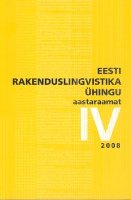Ladina õigusterminite vormilisest ja sisulisest korrektsusest
Accuracy of the form and content of Latin legal terms
Author(s): Merike RistikiviSubject(s): Language and Literature Studies
Published by: Eesti Rakenduslingvistika Ühing (ERÜ)
Keywords: legal language; terminology; language mistakes; orthography; syntaxmorphology interaction; Latin; Estonian
Summary/Abstract: The article discusses the orthography of Latin legal terms and its peculiarities, and Latin morphology and its relationship with Estonian sentence. Law is a fi eld where linguistic means of expression are of utmost importance. This discipline operates directly through language; a word or expression acquires juridical power in it. The material analysed comprises the terms collected from the law review Juridica issued from 1993 to 2007. The time period looked at in the given research has been a decisive era in the development of Estonian law: it is characterised by turning back to the Western legal environment which largely depends on the Latin language. The legal reform in Estonia has been accompanied by changes in the usage of terms by Estonian lawyers. The integration of Estonian legal language into European legal culture is refl ected by a relatively high increase in the usage of terms in Latin. At the same time, there occur several problems when Latin terms are employed. In Latin, a synthetic language, grammatical relationships are represented by applying suffi xes and infl ectional endings. As a result, the recognition and understanding of a Latin term may be affected by distinguishing the singular and the plural form, as well as using of a term in different case forms or with various prepositions. Diffi culties in understanding can also be caused by the use of a less known Latin expression or the improper use of an expression in a sentence. Mistakes frequently appear in the spelling of Latin terms, as well as in the agreement between case forms and gender forms and in translation of Latin terms. The most common problem when using Latin terms, however, is adapting the foreign words to the context and incorporating them into the Estonian sentences. Ordinarily mistakes occur in the usage of two forms – the basic form in the nominative case and the adverbial in the ablative – in the proper context.
Journal: Eesti Rakenduslingvistika Ühingu aastaraamat
- Issue Year: 2008
- Issue No: 4
- Page Range: 157-170
- Page Count: 14
- Language: Estonian

